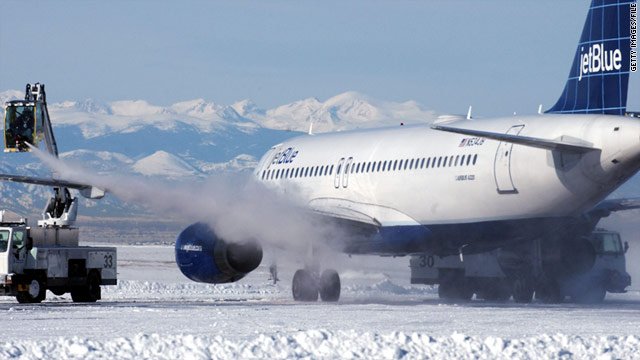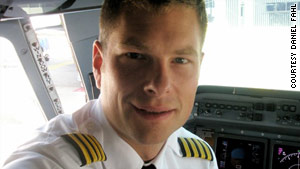Airplane deicing: The how and why

- Snow and ice accumulation on a plane disrupts airflow across the aircraft's surface
- Deicing fluid removes ice and snow; it's made up primarily of a chemical called glycol
- A separate treatment, anti-icing, is used when precipitation is falling to prevent more buildup
Editor's note: Daniel Fahl is a captain for a major U.S. airline. He has been a pilot for 10 years.
(CNN) -- If you've traveled by air in wintry weather, you've probably looked out your window before takeoff and seen vehicles circling the plane, spraying deicing fluid on the wings. Passengers often ask me why it's so important to make sure the aircraft is free of snow and ice accumulation.
Not just removing, but also preventing a build-up of snow and ice on the wings and tail of an airplane is crucial for a safe take-off. A plane's wings and rear tail component are engineered with a very specific shape in order to provide proper lift for flight. Snow and ice on these areas in essence changes their shape and disrupts the airflow across the surface, hindering the ability to create lift.
Whenever snow, ice, or even frost has accumulated on the aircraft, the pilots call on the airport deicing facility to have it removed. Deicing fluid, a mixture of a chemical called glycol and water, is generally heated and sprayed under pressure to remove ice and snow on the aircraft.
While it removes ice and snow, deicing fluid has a limited ability to prevent further ice from forming. If winter precipitation is falling, such as snow, freezing rain or sleet, further action needs to be taken to prevent ice from forming again on the aircraft before takeoff.

In these cases, anti-icing fluid is applied after the deicing process is complete. This fluid is of a higher concentration of glycol than deicing fluid. It has a freezing point well below 32 degrees Fahrenheit or zero Celsius and therefore is able to prevent the precipitation that falls into it from freezing on the plane's surface.
Anti-icing fluid also has an additive that thickens it more than deicing fluid to help it adhere to aircraft surfaces as it speeds down the runway during takeoff.
Pilots temporarily disable the aircraft's ventilation system during the deicing/anti-icing process to prevent fluid fumes from entering the cabin. Although the fumes are considered nontoxic for inhalation, we try to keep the odor out of the cabin regardless. Sometimes the scent, similar to maple syrup, does find its way into the aircraft cabin.
As the anti-icing fluids lose their effectiveness in flight, the aircraft is still equipped with systems that prevent frozen precipitation from building on the wings, tail and various sensors around the airplane. These systems are not only important in the winter months, but also in the summer months, because at higher altitudes, the temperature is well below freezing year-round.
Typically aircraft systems prevent ice buildup in one of two ways. On most jet aircraft, hot air from the engines is routed through piping in the wings, tail and engine openings to heat their surfaces and prevent icing.
Preventing ice formation in the engine openings is important, as ice here could dislodge and cause damage as it's ingested into the engine. This occurrence would be similar to throwing a rock into a running washing machine -- clearly not a good idea.
On propeller driven aircraft, balloon-like devices attached to the wings and tail are inflated and deflated with air from the engines, breaking up any ice accumulation.
We can't promise your trip to the airport will be ice-free, but there won't be any icy buildup on the plane getting you to your holiday destination.
